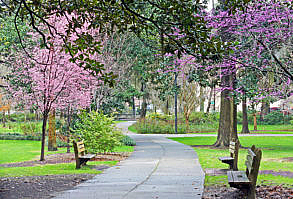Georgia has a lot to offer history buffs. There are a number of National Historic Sites as well as State Historic Sites scattered throughout Georgia. These sites pertain to colonial and civil war history as well as two American Presidents.
Since Georgia has been the home to many of the greatest civil rights leaders and produced many great African Americans musicians, politicians, and athletes, the state has a number of sites that will be of interest to those wanting to learn about African American heritage.
Please click on one of the following links for more information about these historic tourism sites in the state of Georgia:
1- Georgia National Historic Sites
2- Georgia State Historic Sites
3- Georgia African American Heritage Sites
The National Park Service of the U.S. Department of the Interior operates twelve historic sites, parks, monuments, and trails within the state of Georgia. A brief description and a link to each is provided below:
Andersonville National Historic Site
Andersonville is the site of the infamous Civil War POW camp, Camp Sumter, where thousands of Union prisoners died. The National Prisoner of War Museum and the Andersonville National Cemetery are also here. This site is located in Andersonville, GA.
Appalachian National Scenic Trail
The Appalachian National Scenic Trail is a 2,175-mile-long path that stretches from Georgia to Maine. This is a wild and scenic route through the Appalachian Mountains that an estimated 4,000,000 people a year enjoy.
Chattahoochee National Recreation Area
The Chattahoochee National Recreation Area is located in the Atlanta area in which hiking, jogging, casual rafting, and picnicking are enjoyed by thousands. This is a beautiful river that supplies water to much of the Atlanta area.
Chickamauga and Chattanooga National Military Park
The Chickamauga and Chattanooga National Military Park commemorates two strategic Civil War battlefields – Chickamauga and Lookout Mountain – where, in 1863, Union and Confederate troops fought over control of Chattanooga and its key rail lines.
Cumberland Island National Seashore
Cumberland Island is a beautiful island at the southernmost end of Georgia’s coast in which nature has been preserved. A limited number of people are allowed access, but this makes the visit even more special. Hiking, swimming, camping, bird watching, and photography are among several of the activities to be enjoyed. The beaches are undeveloped and wild horses roam the island.
Fort Frederica National Monument
The town of Frederica was founded in 1736 by General James Oglethorpe to provide a defensive outpost for the Georgia colony. Troops from Fort Frederica defeated Spanish troops in 1742 during The Battle of Bloody Marsh, confirming England’s claim to the colony.
Fort Pulaski National Monument
Fort Pulaski National Monument is in the Savannah area on Cockspur Island. In April 1862 the Battle for Fort Pulaski marked the first real use of rifled cannon. Fired from over a mile away, they completely destroyed the fort, which surrendered.
This marked a point in military history when it was widely acknowledged that masonry fortifications would no longer be of use. Cockspur Island has 5,000 acres of saltwater marshes and natural habitat can be explored on the walking trails.
Jimmy Carter National Historic Site
The Jimmy Carter National Historic Site is located in Plains, Georgia where Jimmy and Rosalynn Carter grew up and lived. The site preserves the key parts of the community that shaped their lives. The Carter Presidential Center is in Atlanta and houses both the Carter Presidential Library and Museum and The Carter Center.
Kennesaw Mountain National Battlefield Park
Kennesaw Mountain National Battlefield Park is located in Kennesaw, Georgia just northwest of Atlanta. In June of 1864 over 5,000 soldiers were killed in a two-week period in some of the heaviest fightings of the Atlanta campaign in which out of a total of 163,000 soldiers, 67,000 were killed, wounded, or captured. The National Battlefield contains three actual battlefields, and there are over 17 miles of walking trails.
Martin Luther King, Jr. National Historic Site
Martin Luther King, Jr. National Historic Site in Atlanta preserves the legacy of the great civil rights leader. The site includes Dr. King’s birth home, the Ebenezer Baptist Church, and The King Center.
Ocmulgee National Monument
The Ocmulgee National Monument in Macon is a memorial that preserves a record of life in the Southeast and focuses on both people and natural resources.
Old Fort Jackson
Fort James Jackson, also known as Old Fort Jackson, has been a part of Coastal Georgia’s history for nearly two centuries. Named in honor of Georgia governor and Revolutionary War soldier James Jackson, the fort is the oldest standing brick fortification in the state.
Trail of Tears National Historic Trail
Trail of Tears National Historic Trail is memorializes the trail that 16,000 Cherokee Indians took from North Carolina, Alabama, Tennessee and Georgia westward to Oklahoma after being forcibly removed from their homes. Hundreds died on the trail and thousands more after they got to Oklahoma. The Trail commemorates their survival as well as their journey.







